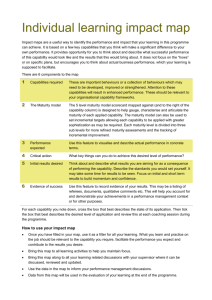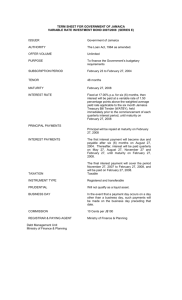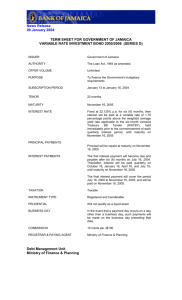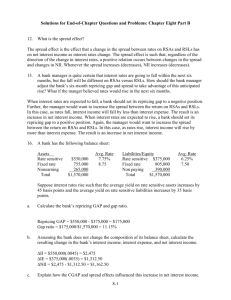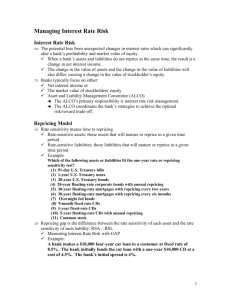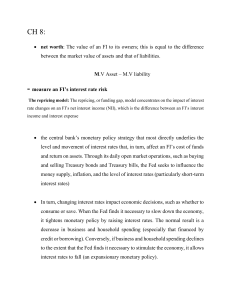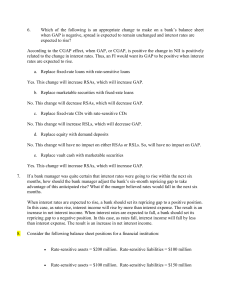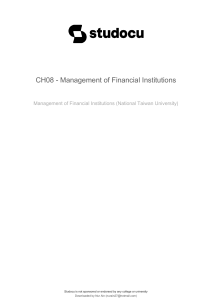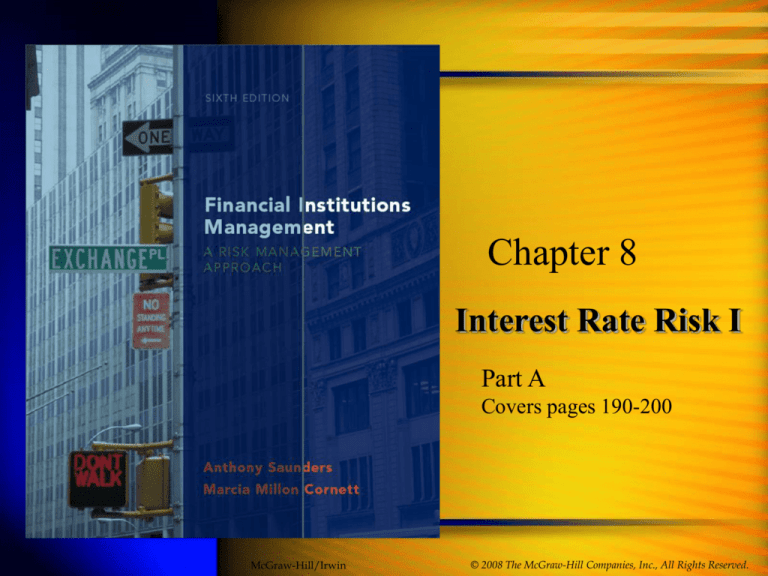
Chapter 8
Interest Rate Risk I
Part A
Covers pages 190-200
McGraw-Hill/Irwin
© 2008 The McGraw-Hill Companies, Inc., All Rights Reserved.
Overview
8-2
This chapter discusses the interest rate risk
associated with financial intermediation:
Federal Reserve monetary policy
Repricing model
Maturity model
Duration model
*Term structure of interest rate risk
*Theories of the term structure of interest
rates
Loanable Funds Theory
8-3
Interest rates reflect supply and demand for
loanable funds
Shifts in supply or demand generate interest
rate movements as market forces establish
a new equilibrium
Determination of Equilibrium Interest Rates
8-4
8-5
Note that
y-axis is
bond
PRICE
Increase in Demand for Bonds
8-6
Bond Supply Shift – Increase in Supply
8-7
8-8
8-9
8-10
8-11
8-12
Level & Movement of Interest Rates
Federal Reserve Bank: U.S. central bank
Open market operations influence money
supply, inflation, and interest rates
Actions of Fed in response to 2001 attacks on
World Trade Center
Lowered interest rates 11 times during the year
June 2004- August 2006
inflation concerns take prominence
17 consecutive increases in interest rates
Central Bank and Interest Rates
Target is primarily short term rates
Focus on Fed Funds Rate in particular
Interest rate changes and volatility
increasingly transmitted from country to
country
Statements by Ben Bernanke can have
dramatic effects on world interest rates.
8-13
Repricing Model
8-14
Repricing or funding gap model based on
book value.
Contrasts with market value-based maturity
and duration models recommended by the
Bank for International Settlements (BIS).
Rate sensitivity means time to repricing.
Repricing gap is the difference between the
rate sensitivity of each asset and the rate
sensitivity of each liability: RSA - RSL.
Refinancing risk
Maturity Buckets
8-15
Commercial banks must report repricing
gaps for assets and liabilities with maturities
of:
One day.
More than one day to three months.
More than 3 three months to six months.
More than six months to twelve months.
More than one year to five years.
Over five years.
Repricing Gap Example
Assets
1-day
$ 20
>1day-3mos.
30
>3mos.-6mos. 70
>6mos.-12mos. 90
>1yr.-5yrs.
40
>5 years
10
Liabilities
$ 30
40
85
70
30
5
Gap Cum. Gap
$-10
$-10
-10
-20
-15
-35
+20
-15
+10
-5
+5
0
8-16
Applying the Repricing Model
8-17
DNIIi = (GAPi) DRi = (RSAi - RSLi) DRi
Example:
In the one day bucket, gap is -$10 million. If rates
rise by 1%,
DNII(1) = (-$10 million) × .01 = -$100,000.
Applying the Repricing Model
Example II:
If we consider the cumulative 1-year gap,
DNII = (CGAPone year) DR = (-$15 million)(.01)
= -$150,000.
8-18
Rate-Sensitive Assets
8-19
Examples from hypothetical balance sheet:
Short-term consumer loans. If repriced at yearend, would just make one-year cutoff.
Three-month T-bills repriced on maturity every
3 months.
Six-month T-notes repriced on maturity every 6
months.
30-year floating-rate mortgages repriced (rate
reset) every 9 months.
Rate-Sensitive Liabilities
8-20
RSLs bucketed in same manner as RSAs.
Demand deposits and passbook savings
accounts warrant special mention.
Generally considered rate-insensitive (act as
core deposits), but there are arguments for their
inclusion as rate-sensitive liabilities.
CGAP Ratio
May be useful to express CGAP in ratio
form as,
CGAP/Assets.
8-21
Provides direction of exposure and
Scale of the exposure.
Example:
CGAP/A = $15 million / $270 million = 0.56, or
5.6 percent.
8-22
Equal Rate Changes on RSAs, RSLs
Example: Suppose rates rise 2% for RSAs
and RSLs. Expected annual change in NII,
DNII = CGAP × D R
= $15 million × .01
= $150,000
With positive CGAP, rates and NII move in
the same direction.
Change proportional to CGAP
Unequal Changes in Rates
8-23
If changes in rates on RSAs and RSLs are
not equal, the spread changes. In this case,
DNII = (RSA × D RRSA ) - (RSL × D RRSL )
Unequal Rate Change Example
8-24
Spread effect example:
RSA rate rises by 1.2% and RSL rate rises by
1.0%
DNII = D interest revenue - D interest
expense
= ($155 million × 1.2%) - ($155 million ×
1.0%)
= $310,000
Restructuring Assets & Liabilities
8-25
The FI can restructure its assets and
liabilities, on or off the balance sheet, to
benefit from projected interest rate changes.
Positive gap: increase in rates increases NII
Negative gap: decrease in rates increases NII
Example: Macatawa Bank’s one-year repricing
gap ratio of -5.23 percent.
Effect of rising interest rates in 2006:
Bad luck?
Or Bad Management?
Weaknesses of Repricing Model
8-26
Weaknesses:
Ignores market value effects and off-balance
sheet (OBS) cash flows
Overaggregative
Distribution of assets & liabilities within individual
buckets is not considered. Mismatches within
buckets can be substantial.
Ignores effects of runoffs
Bank continuously originates and retires consumer
and mortgage loans and demand deposits/passbook
account balances can vary. Runoffs may be ratesensitive.
Prime Rate Versus CD Rates
8-27
A Word About Spreads
Text example: Prime-based loans versus
CD rates
What about libor-based loans versus CD
rates?
What about CMT-based loans versus CD
rates
What about each loan type above versus
wholesale funding costs?
This is why the industry spreads all
items to Treasury or LIBOR
8-28
*The Maturity Model
8-29
Explicitly incorporates market value effects.
For fixed-income assets and liabilities:
Rise (fall) in interest rates leads to fall (rise) in
market price.
The longer the maturity, the greater the effect of
interest rate changes on market price.
Fall in value of longer-term securities increases
at diminishing rate for given increase in interest
rates.
Maturity of Portfolio*
8-30
Maturity of portfolio of assets (liabilities)
equals weighted average of maturities of
individual components of the portfolio.
Principles stated on previous slide apply to
portfolio as well as to individual assets or
liabilities.
Typically, maturity gap, MA - ML > 0 for most
banks and thrifts.
*Effects of Interest Rate Changes
Size of the gap determines the size of
interest rate change that would drive net
worth to zero.
Immunization and effect of setting
MA - ML = 0.
8-31
8-32
*Maturities and Interest Rate Exposure
If MA - ML = 0, is the FI immunized?
Extreme example: Suppose liabilities consist of
1-year zero coupon bond with face value $100.
Assets consist of 1-year loan, which pays back
$99.99 shortly after origination, and 1¢ at the
end of the year. Both have maturities of 1 year.
Not immunized, although maturity gap equals
zero.
Reason: Differences in duration**
**(See Chapter 9)
*Maturity Model
8-33
Leverage also affects ability to eliminate
interest rate risk using maturity model
Example:
Assets: $100 million in one-year 10-percent
bonds, funded with $90 million in one-year 10percent deposits (and equity)
Maturity gap is zero but exposure to interest rate
risk is not zero.
*Duration
8-34
The average life of an asset or liability
The weighted-average time to maturity using
present value of the cash flows, relative to
the total present value of the asset or liability
as weights.
*Term Structure of Interest Rates
YTM
YTM
Time to Maturity
Time to Maturity
Time to Maturity
Time to Maturity
8-35
*Unbiased Expectations Theory
8-36
Yield curve reflects market’s expectations of
future short-term rates.
Long-term rates are geometric average of
current and expected short-term rates.
_
_
~
~
RN = [(1+R1)(1+E(r2))…(1+E(rN))]1/N – 1
2 / (1+ R ))) - 1
f
=
((1+
R
)
2 1
1 2
1 1
*Liquidity Premium Theory
Allows for future uncertainty.
Premium required to hold long-term.
8-37
8-38
*Market Segmentation Theory
8-39
Investors have specific needs in terms of
maturity.
Yield curve reflects intersection of demand
and supply of individual maturities.
Pertinent Websites
For information related to central bank
policy, visit:
Bank for International Settlements:
www.bis.org
Federal Reserve Bank:
www.federalreserve.gov
8-40


